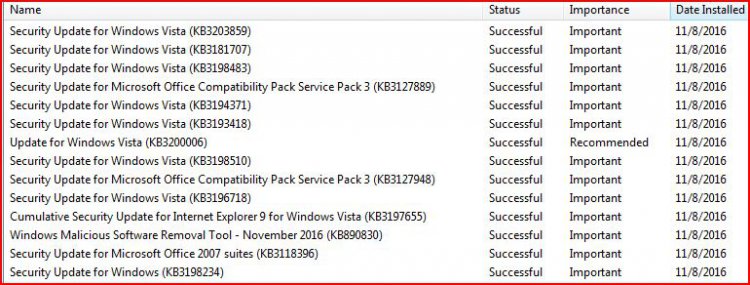...the last two months have been increasingly frustrating as the times have increased significantly, it took me almost 3 hours for October and this month took almost 5 1/2 hours. I'm wondering if others have seen trend and why Imacri's time is so much quicker. Maybe it is the time of day we perform the task (I always do it midday), what browser we use, keeping the computer idle during the update process, or just something else different between each of us...
Hi sheldon3:
I don't have a definitive answer as to why there is such a wide range in the length of time it takes the initial "
Checking for updates..." phase of Windows Updates to run to completion on different Vista SP2 computers, but I'm relatively certain that it has nothing to do with your choice of default browser or internet connection speed - your connection speed should only affect the amount of time it takes Windows Update to download available updates from the Microsoft servers once the "
Checking for updates..." phase has finished looking for available updates.
According to the background information Dalai posted at
http://wu.krelay.de/en/info.htm, installing the Windows kernel-mode driver (Win32K.sys) speed up patches listed each month on his home page at
Search for Windows Updates takes forever? - A possible solution simply "tricks" the Windows Update Agent into searching the update catalog wsusscn2.cab faster. My post # 16 in uberbleeper's
What actually causes wuauserv high CPU use updating Windows in the bleepingcomputer forum has some additional information on the cause of these slow Windows Updates, but my understanding is that the two main factors contributing to the slow Windows Update (aside from hardware considerations such as 32-bit vs. 64-bit OS, CPU speed and amount of RAM) are:
- The Windows Update Agent (WUA) v7.6.7600.256 (C:\Windows\system32\wuaueng.dll) for Vista SP2 has not been updated since June 2012 and is not optimized for computers with slower CPUs and limited amounts of RAM
- Microsoft has not performed regular purges of expired (superseded) updates in Vista's update catalog wsusscn2.cab since Win 10 was officially released on 29-Jul-2015
Aside from installing the recommended Win32K.sys speed up patches each Patch Tuesday (the second Tuesday of the month), here are a few suggestions that
might also help:
- Check your list of startup programs that load automatically at boot-up and consume available RAM (memory). Most Vista SP2 machines have a limited amount of RAM installed, and if users are consuming all their available RAM by loading unnecessary programs and diagnostic utilities at boot-up this can slow down the "Checking for updates..." phase of Windows Update (i.e., when the Windows Update Agent is searching the wsusscn2.cab update catalog) even further. See my note below about other ways to free up system resources when running Windows Update.
- Disable automatic Windows Updates [Windows Update | Change settings | Important updates | Never check for updates (not recommended) and re-boot] to prevent Windows Update from running in the background and consuming CPU and other system resources. Run manual Windows Updates [Windows Update | Check for updates] at a time of your choosing when you can leave your system alone for a few hours. I only run a manual Windows Update once a month after each Patch Tuesday (the second Tuesday of the month), and only after I've installed Dalai's suggested speed up patch.
- If you have a "traditional" (MSI) version of Microsoft Office 2007 or later then run a manual Windows Update shortly after the first Tuesday of the month when non-security updates are released - this will mean fewer updates for Windows Update to install on Patch Tuesday (the second Tuesday of the month). Note that security updates for the MSI versions of MS Office and all updates for Click-to-Run versions of MS Office are still released on Patch Tuesday on the second Tuesday of the month - see the MS TechNet article Upcoming change to the release schedule for non-security updates.
I use Norton Internet Security (NIS) as my antivirus and I always turn on
Silent Mode when I run Windows Update. This
temporarily suspends background maintenance tasks like Automatic LiveUpdates, Quick Scans, etc. but doesn't disable AutoProtect (real-time virus protection) or my Norton Smart Firewall. Anything you can do to prevent third-party software from consuming CPU and RAM (memory) without compromising your system security should theoretically help speed up Windows Update.
-------------
32-bit Vista Home Premium SP2 * Firefox v50.0 * NIS v22.8.0.50 * MBAM Premium v2.2.1


